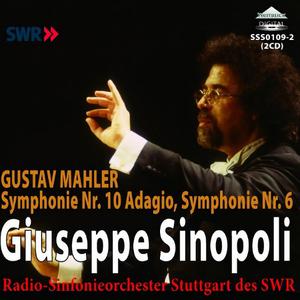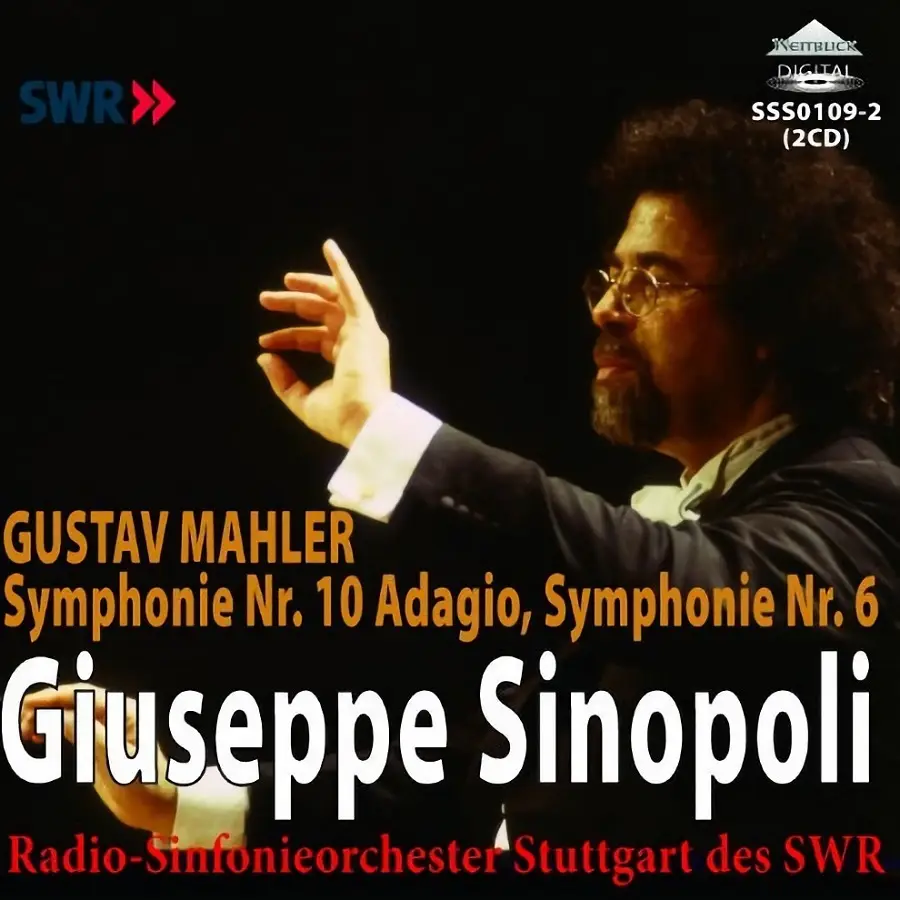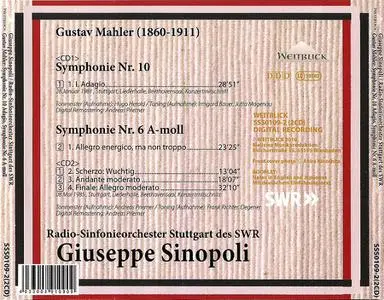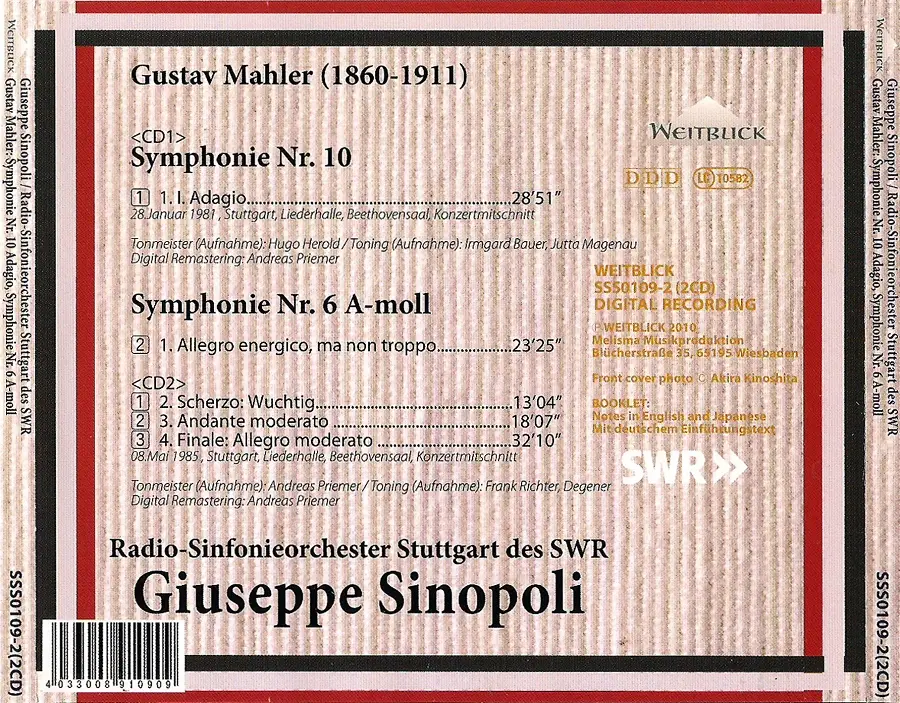Giuseppe Sinopoli, Radio Symphonieorchester Stuttgart des SWR - Gustav Mahler: Symphonies Nos. 6 & 10 (2010)
EAC | FLAC | Image (Cue & Log) ~ 542 Mb | Total time: 52:16+63:21 | Scans included
Classical | Label: Weitblick | # SSS0109-2 | Recorded: 1981, 1985
EAC | FLAC | Image (Cue & Log) ~ 542 Mb | Total time: 52:16+63:21 | Scans included
Classical | Label: Weitblick | # SSS0109-2 | Recorded: 1981, 1985
Giuseppe Sinopoli was a conductor quite versed in Mahler’s music. He left recordings of all the Mahler symphonies made for Deutsche Grammophon (DGG). It is well known that each of these performances is on the highest level. So it is natural that most listeners think these Mahler recordings are the last word of Sinopoli’s interpretation.
However, Sinopoli was a conductor who was able to perform like a totally different person in each concert. After his death, many live recordings never introduced were published by people who admire the great achievements of this conductor. An outstanding example is Mahler’ s Symphony No. 9 with the Staatskapelle Dresden, released by the Profil label. The particular point of this Mahler 9 is its total length. In comparison with the DGG issue, Sinopoli selected much slower tempos which made the full piece over 10 minutes longer. And he created terrible sensual excitement, frequently using tempo rubato consciously.
In principle Sinopoli was regarded as a scholarly conductor by the audience. In other words, it often considered him a conductor who preferred argumentative performances. I was one of these kinds of audience. But when I attended his concerts, I realized that such easy, simple and superficial characterization was absolutely wrong. On that occasion he conducted Elektra by Richard Strauss, and I was intoxicated with its sound banquet - faint sounds which were barely audible, loudest sounds which astonished the listener, barbarous tone and contrarily fascinating tone. It was really sound magic, like a flood displayed in front of me. This experience let me consider that Sinopoli might be an individual who was dissatisfied if he could not make everything dramatic, although he seemed to like to accomplish analytic and interpretative performances. If it is permissible to say, I felt furthermore it was his intention to create an intense entertainment.
Mahler’ s Symphony No. 6 and the Adagio from Symphony No. 10 introduced by this disk are marvelous performances expressing well the characteristics of Sinopoli, a phenomenal conductor who was not at all easy to understand by ordinary methods. It is important to pay attention to the difference of string settings between the performance with the Philharmonia (DGG) and this one. In case of the performance with the Philharmonia, Sinopoli chose the classic stage formation. The first and second violins were set each end of the stage. The bass strings - cello and contrabass - Were at the left. But the modern setting (the bass strings on the right) was used in this performance. Sinopoli declared on every occasion that Mahler’s pieces should beplayed with the classic stage formation. He did so in almost all the studio recordings, but did rarely in live concert. Is it also a refined contradiction of Sinopoli? It seems he gave priority to the easier performance configuration for the live concert.
Sinopoli frequently performed with the Stuttgart Radio Symphony Orchestra (SWR). Unfortunately, however, on disk there is only one piece recorded by them in collaboration- Lou Salome, composed by Sinopoli himself (DGG). The Mahler performance on this disk can make the listener happier, since the sounds brought by this orchestra are quite beautiful and full of delicacy.
The performance of the Symphony No. 6 with the Philharmonia gave the music lovers a lot to talk about because of its rather slow tempo. The performance on this disk also deines each element of the piece by its slow tempo, but it often somewhat reduces the driving force. Since the first movement is a march, there may be some listeners who consider this tempo selection is not especially appropriate. When I listened to the Philharmonia performance, I thought so too. However in the performance of this disk, a live performance in front of an audience, it seems everything is settled perfectly.
The first movement is undoubtedly relatively slow. But this poetic performance, as if we are appreciating the picture, is a method of bringing the Symphony No. 6 close to the world of Mahler’s late works such as No. 9. In the second movement, Scherzo, the slow tempo continues, and it reminds us of the second movement of Symphony No. 9. It is a performance in which the complicated connections of the themes are resolved clearly. The third movement is the most beautiful part of this piece and Sinopoli lets the orchestra sing melody to the full. The only thing the listener can do is to entrust oneself to the music. One aspect of Sinopoli is his passionate conducting, but in this performance he may control the pathos.
Following the way of the preceding three movements, the fourth movement is far from strenuous hard effort. Thanks to this kind of music making, the moment when the sounds of bells and cowbells come in the distance is a fascinating instant which is unbelievable in the real world. Many performances decline to aggressive and violent power, but the tranquil atmosphere of this performance is unique and phenomenal. At the same time, however, there are sometimes extremely fierce moments, such as the beginning of the melody coming like a tsunami - not hugebut full of impact.
The coupling piece is the adagio from Symphony No. 10. The length of the performance with the Philharmonia is beyond 30 minutes - a grand scale performance. The performance of this disk is similar to the Philharmonia version, reducing a little bit its extreme excesses. Romantic expression, making the strings sing to their heart’s content, is one of Sinopoli’s greatest specialties. We can appreciate the beauty of this performance over and over without ever exhausting its fascination.–Sumiaki Ohno
Performer:
Radio Symphonieorchester Stuttgart des SWR
Giuseppe Sinopoli, conductor
Track List:
Gustav Mahler (1860-1911)
CD1:
Symphony No. 10 Adagio in F sharp major
01. Adagio
Symphony No. 6 in A minor
02. I. Allegro energico, Ma non troppo
CD2:
01. II. Scherzo: Wuchtig
02. III. Andante Moderato
03. IV. Finale: Allegro Moderato
Exact Audio Copy V1.5 from 20. February 2020
EAC extraction logfile from 5. June 2022, 15:17
Gustav Mahler; Giuseppe Sinopoli, Radio‐Sinfonieorchester Stuttgart des SWR / Symphonie Nr. 10 Adagio / Symphonie Nr. 6 A-moll
Used drive : hp DVDRW GUE1N Adapter: 1 ID: 0
Read mode : Secure
Utilize accurate stream : Yes
Defeat audio cache : No
Make use of C2 pointers : No
Read offset correction : 6
Overread into Lead-In and Lead-Out : No
Fill up missing offset samples with silence : Yes
Delete leading and trailing silent blocks : No
Null samples used in CRC calculations : Yes
Used interface : Native Win32 interface for Win NT & 2000
Used output format : Internal WAV Routines
Sample format : 44.100 Hz; 16 Bit; Stereo
TOC of the extracted CD
Track | Start | Length | Start sector | End sector
––––––––––––––––––––––––––––-
1 | 0:00.00 | 29:03.23 | 0 | 130747
2 | 29:03.23 | 23:36.49 | 130748 | 236996
Range status and errors
Selected range
Filename C:\Users\Utente\Music\Gustav Mahler; Giuseppe Sinopoli, Radio‐Sinfonieorchester Stuttgart des SWR - Symphonie Nr. 10 Adagio , Symphonie Nr. 6 A-moll.wav
Peak level 91.4 %
Extraction speed 3.0 X
Range quality 99.9 %
Test CRC B9A1A74C
Copy CRC B9A1A74C
Copy OK
No errors occurred
AccurateRip summary
Track 1 accurately ripped (confidence 1) [CEA9046D] (AR v1)
Track 2 accurately ripped (confidence 1) [4B9BA8D3] (AR v1)
All tracks accurately ripped
End of status report
–– CUETools DB Plugin V2.1.6
[CTDB TOCID: 83SoSH2GUTtCzJHcB0TsMoTWrMg-] found
Submit result: 83SoSH2GUTtCzJHcB0TsMoTWrMg- has been confirmed
Track | CTDB Status
1 | (8/8) Accurately ripped
2 | (8/8) Accurately ripped
Exact Audio Copy V1.5 from 20. February 2020
EAC extraction logfile from 5. June 2022, 16:01
Gustav Mahler; Giuseppe Sinopoli, Radio‐Sinfonieorchester Stuttgart des SWR / Symphonie Nr. 10 Adagio / Symphonie Nr. 6 A-moll
Used drive : hp DVDRW GUE1N Adapter: 1 ID: 0
Read mode : Secure
Utilize accurate stream : Yes
Defeat audio cache : No
Make use of C2 pointers : No
Read offset correction : 6
Overread into Lead-In and Lead-Out : No
Fill up missing offset samples with silence : Yes
Delete leading and trailing silent blocks : No
Null samples used in CRC calculations : Yes
Used interface : Native Win32 interface for Win NT & 2000
Used output format : Internal WAV Routines
Sample format : 44.100 Hz; 16 Bit; Stereo
TOC of the extracted CD
Track | Start | Length | Start sector | End sector
––––––––––––––––––––––––––––-
1 | 0:00.00 | 13:17.21 | 0 | 59795
2 | 13:17.21 | 18:10.10 | 59796 | 141555
3 | 31:27.31 | 32:07.04 | 141556 | 286084
Range status and errors
Selected range
Filename C:\Users\Utente\Music\Gustav Mahler; Giuseppe Sinopoli, Radio‐Sinfonieorchester Stuttgart des SWR - Symphonie Nr. 10 Adagio , Symphonie Nr. 6 A-moll CD2.wav
Peak level 96.6 %
Extraction speed 3.1 X
Range quality 100.0 %
Test CRC E8E0C34A
Copy CRC E8E0C34A
Copy OK
No errors occurred
AccurateRip summary
Track 1 accurately ripped (confidence 1) [B4FC0896] (AR v1)
Track 2 accurately ripped (confidence 1) [390D26E5] (AR v1)
Track 3 accurately ripped (confidence 1) [15C93392] (AR v1)
All tracks accurately ripped
End of status report
–– CUETools DB Plugin V2.1.6
[CTDB TOCID: leRY2akrh.ZdsSRqUPD_X4_VeAA-] found
Submit result: leRY2akrh.ZdsSRqUPD_X4_VeAA- has been confirmed
Track | CTDB Status
1 | (10/10) Accurately ripped
2 | (10/10) Accurately ripped
3 | (10/10) Accurately ripped
Thanks to the original releaser





